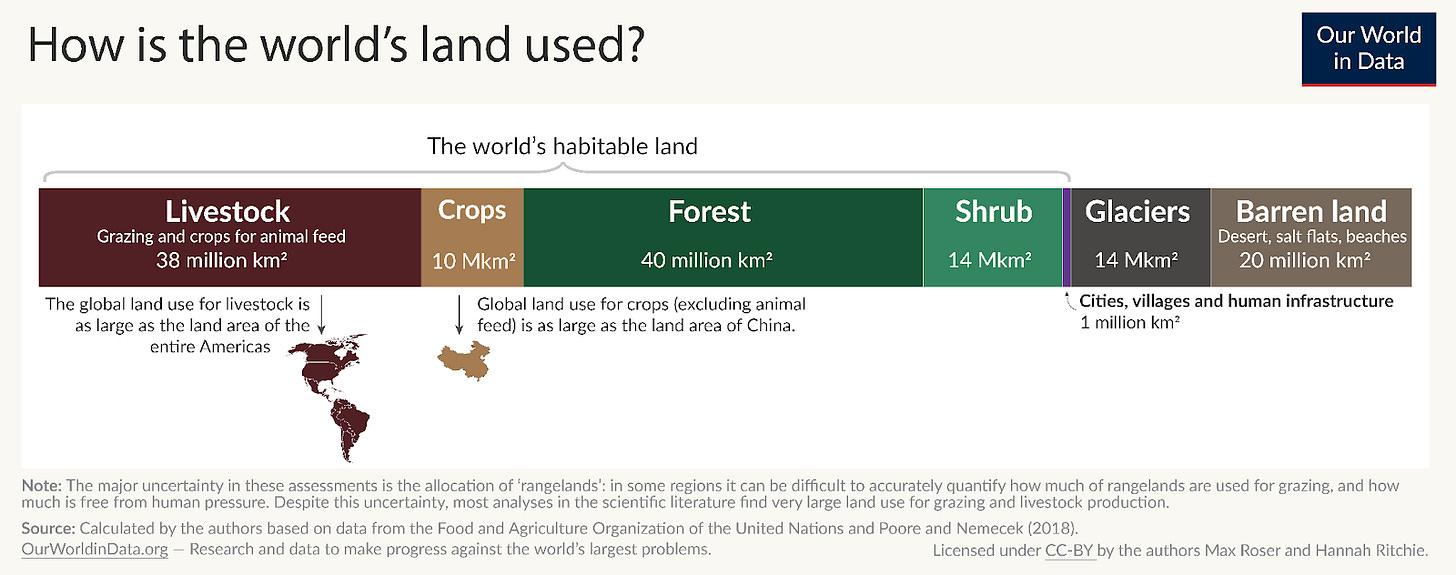We can terraform the Earth—not just Mars
If we can revive a dead planet, we can revive our own.
This essay is for TERRAFORM, an essay collection about the future of our planet. Support the project by collecting the digital or print edition 👇🏻
Terraforming Mars has long been a trope of science fiction. Could tiny particles injected into the planet’s atmosphere warm the planet, melt its ice caps, and turn it into a habitable planet?
Something that’s long interested me: Could we terraform Earth too? Could we make the parts of our world that are currently uninhabitable, habitable? Could we even mitigate the effects of climate change and make the world a better place to live?
If it’s within our realm of possibility to revive a dead planet, then it’s certainly within our realm of possibility to make an already alive planet thrive, and even to reverse the damage we have thus far inflicted.
We already are.
Over the last 50 years, China has been planting a Great Green Wall, 116,000 square miles of forest along the Gobi and Taklamakan deserts designed to halt their spread and stop sand storms and poor air quality from plaguing the country. Another Chinese project in Loess Plateau project turned a dusty wasteland the size of France into terraced farmland, dramatically increasing rainfall, crop yield, and biodiversity while restoring an economy to 50 million people. Local incomes doubled and 2.5 million people were lifted out of poverty. With 22% of the world’s population and only 7% of the world’s arable land—China has been turning their deserts into oases, increasing forest coverage from 10% of its territory in 1949 to 25% today.
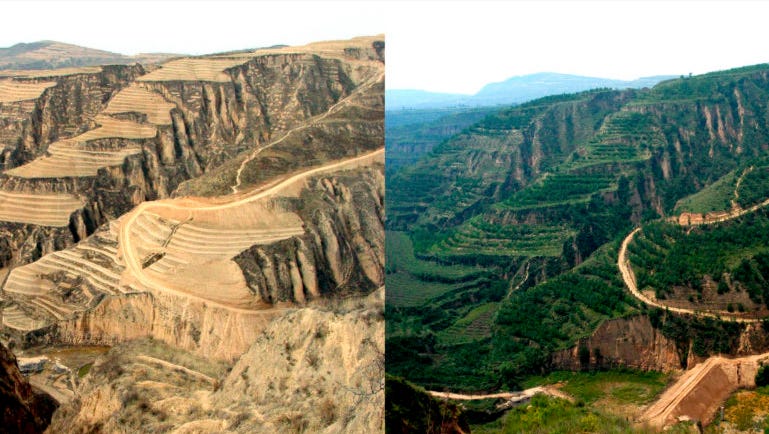
In Africa, another Great Green Wall is halting desert expansion along the Sahara, increasing rainfall, and creating ecosystems where people can live and farm in a formerly barren and uninhabitable landscape. Forty-four million acres (18 million hectares) of degraded lands have already been restored and 350,000 jobs have been created as part of a sweeping project that aims to restore 247 million acres (100 million hectares) of degraded land, sequester 250 million tons of carbon, and create 10 million jobs in rural Africa.
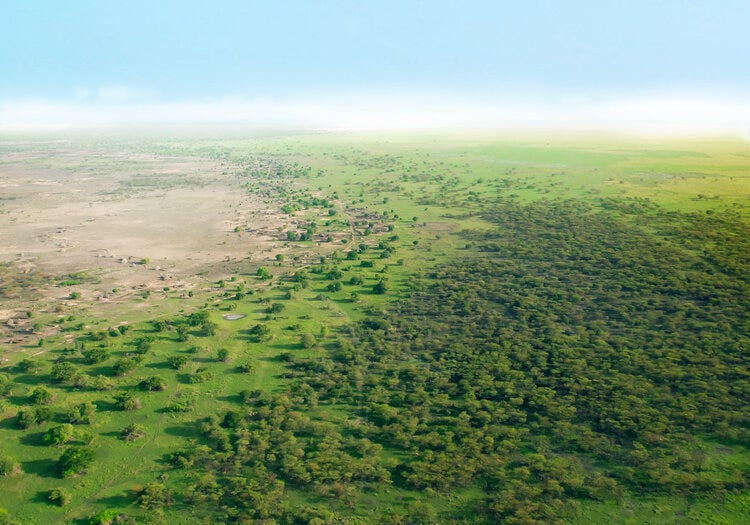
Foresting the Earth will create new ecologies and more habitable land where people and animals can live.
Technology will even allow us to change the weather.
Reflect Orbital is creating a dimmer switch for the sun, with orbital mirrors that can direct the sun’s rays to an arctic village in need of heat or a solar panel farm in need of energy. Rainmaker wants to use cloud seeding technology to generate rain on demand over a forest fire or heat wave, or to irrigate crops. Cloud seeding is already being used to turn hail into slush to avoid damaging crops. Make Sunsets plans to cool the Earth by creating reflective clouds that mimic the effect of volcanos, cooling local climates by 0.9℃ for one to two years. OceanTherm is developing ways to surface water from the colder bottom of the ocean to the top, cooling pockets of the ocean enough to prevent cyclones and avoid the next Hurricane Katrina.
Some geoengineering organizations intend to re-freeze the Arctic, as organizations like Arctic Reflections and Real Ice. My favorite attempt is Pleistocene Park, which aims to create a mini ice age by rewilding Siberia, maybe even with revived Wooly Mammoths. Doing so could keep the intercontinental ice block from thawing too quickly and rapidly releasing greenhouse gasses as it does.
These terraforming innovations mean we are creating a thermostat for the Earth, with geoengineers able to cool or warm the planet as needed, make it rain or freeze where needed, and deter natural disasters before they happen.
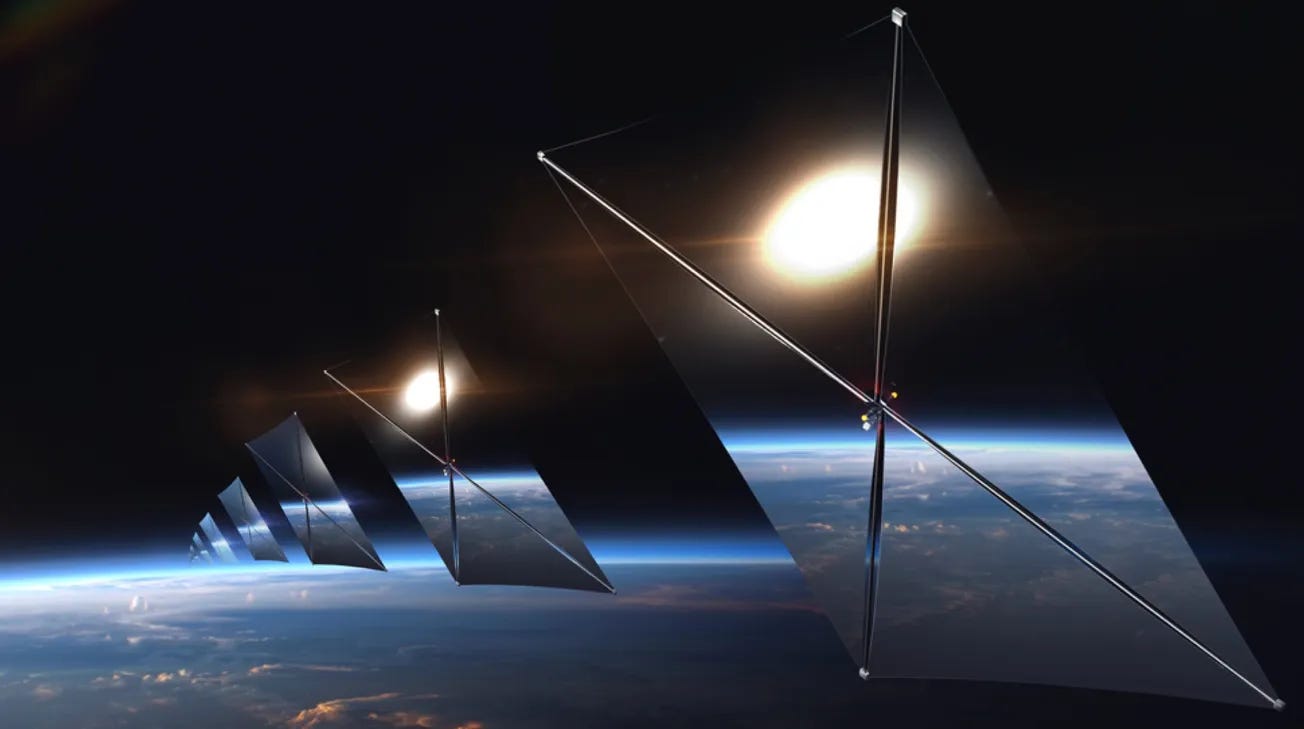
If we can create new ecosystems and change the weather, we can also undo the harms we’ve already done to our planet, cooling the Earth where we’ve previously warmed it.
To limit the Earth’s temperature to the Paris Climate Accord’s 2°C above pre-industrial levels—and avoid associated drought, famine, and mass extinction—we’ll need to remove 7 to 9 gigatons of CO₂ from our atmosphere annually by 2050. We’re already removing 2 gigatons per year, 99.9% of that from forest-based carbon removal projects, largely those in China. We can get the rest of the way by terraforming 8-10% of the Earth’s land, planting roughly 3.7 billion acres of forest (1.5 billion hectares). We can plant 2.2 billion acres of forest (0.9 billion hectares) without disturbing existing urban or agricultural land, increasing the world’s forests by 25% and storing 200 gigatons of carbon at maturity.
Technological innovations can help here too. The other 0.1% of our carbon capture efforts come from rapidly expanding technologies like biochar, which locks carbon in a form of charcoal that can remain in soil for hundreds to thousands of years, and BECCS, which captures the carbon created during power generation and stores it underground. Companies like Equatic are attempting to reach scale, solidifying carbon from the atmosphere while generating carbon-negative hydrogen as a byproduct. An Equatic plant in Singapore aims to remove 10 metric tons of CO₂ per day while producing 300 kilograms of hydrogen. Another in Canada will remove 109,500 metric tons of CO₂ annually while producing 3,600 metric tons of hydrogen. Researchers at UCLA say the approach could theoretically scale to remove 10 gigatons annually.
The most important thing we need to do is stop adding more carbon to our atmosphere, and terraforming helps here too. So far, we’re not on track: CO₂ emissions reached a new height in 2023, when we poured 57.1 gigatons into our atmosphere. To meet Paris standards, emissions need to fall 37% by 2035, and the UN’s 2024 Emissions Gap Report says we can get most of the way there by scaling two readily available and low-cost options: Growing more forests, which could account for 20% of our reduction of emissions by 2035, and replacing coal and gas with solar and wind power, which could account for a further 38%.
Some projects manage to combine the two, like China’s Kubuqi Desert Project, which not only greened a third of the desert and sequestered 14.5 million tons of carbon, but also built the country's largest solar farm above it—the water that regularly cleans the solar panels also waters the plants grown underneath in partial shade.
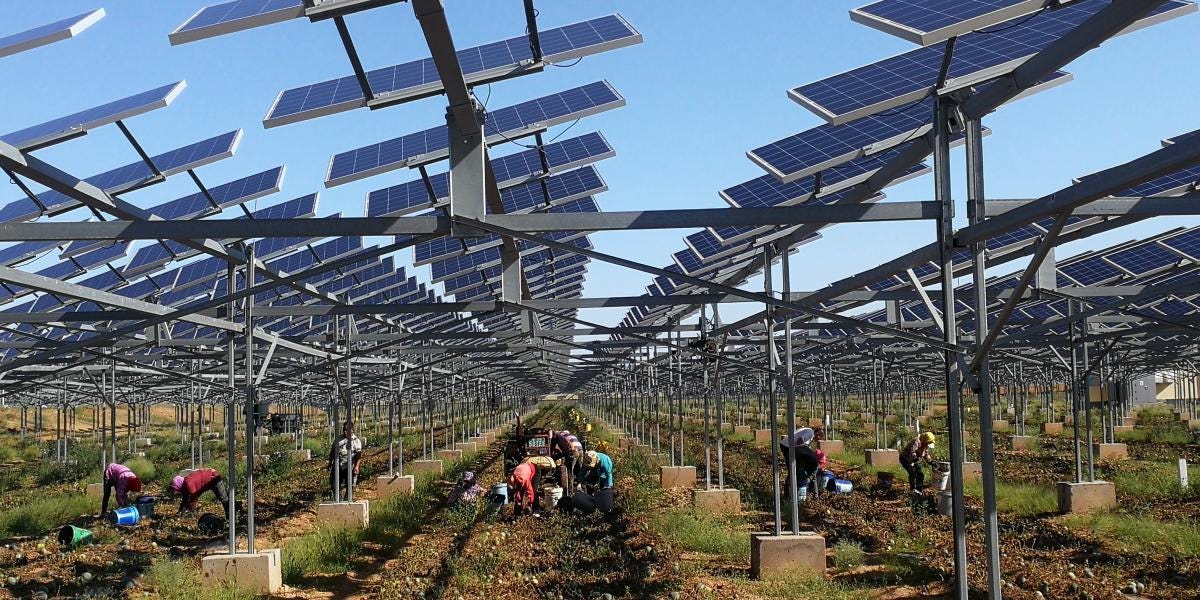
We can even eliminate trash.
Though landfills have been a necessary human intervention for public health and sanitation, in the future we won’t need them as much. Landfill mining could eat away at existing dumps and repurpose those materials—the EU’s New Mine project, for one, aims to reclaim 16 million tons of waste for reuse. We can also clean our ocean, where a garbage “soup” twice the size of Texas currently floats off the coast of California. The Ocean Cleanup Project plans to collect and recycle the plastic mass within 10 years, while introducing river interventions that prevent new waste from reaching the ocean. Organizations like Inxects could even turn every oil rig into a plastic filtering system to keep oceans clean into the future.
Advanced incineration and recycling capabilities keep us from adding new trash to our world—countries like Switzerland, Sweden, Japan, South Korea, Denmark, and Germany already recycle most of their trash and use incineration to reduce the rest by up to 90% while generating electricity and heat. All of these countries send less than 2% of their waste to landfill, and new innovations could reduce that even further: Water hyacinths, fungi, and mealworms can be employed to break down microplastics, and flies are being genetically engineered to break down trash.
Not only can we reduce the existing harms to our Earth, but in the future we won’t need to create new harms at all.
Renewable energies can replace carbon emitting ones, and compostable and recyclable products can replace non biodegradable ones. Companies like Notpla and Ecovative already create packaging out of seaweed and mushrooms, replacing single-use plastics with materials that compost naturally. Loop wants to make all packaging reusable, and Neri Oxman has created a shoe and apparel line that can grow and decompose. We can create a probable future where almost everything we make can easily be repurposed or easily disintegrated.
It’s not just products. Oxman thinks building architecture could be re-engineered to add to our ecological climate rather than destroy it. Her Eden Tower would not just create a place for people to live, but also a living ecosystem that facilitates carbon sequestration, creates water reservoirs from sloped surfaces, and grows urban forests and habitats for birds and animals built into the cityscape.
Our forested garden world, with clean air and no waste, could dramatically reshape our planet by doing one thing: Eliminating livestock.
Right now, half of our habitable land is being used for agriculture, 80% of that for livestock.
But with plant-based and cellular grown meats, we won’t need to use so much of our land for food. WildType and Bluu already grow salmon in a lab, not the ocean, and Believer grows real chicken, beef, and lamb meat with animal cells, not actual animals or land. Believer uses only 1% of the land and 4% of the water used by traditional animal husbandry. Organizations like Solarfoods can even harvest plant proteins out of thin air.
Maybe in the future we won’t need animals for meat at all.
Maybe animals will just be wild.
What might we do with all that freed up land? Rewild it! Grow new foods! Create solar and wind farms! Build new cities! Host more people!!!
This is no longer the realm of science fiction. What once seemed impossible is now entirely plausible. Some of these technologies are just starting out, others are more mature, and many require massive investment on the scale of countries and continents and international banks. But we have the ability to do it. These inventions and interventions exist, countries are already working together to take action on them, and this is only the very beginning of what humans will be able to do to shape our planet.
If we can dream of a plausible future where we terraform planets like Mars, why not ours?
In 100 years, 1,000 years, or 10,000 years there’s no reason we can’t have completely changed the face of our planet, growing forests across our deserts to cool the planet, floating satellites in the sky to change the weather, and controlling volcanic releases to sculpt our cloudcover. Former cities could become vertical arcologies, connected to vast interconnected wild corridors. Seaflooding could turn dusty lakebeds into oases and robot bees could pollinate a world of gardens! Trees could be bioengineered to light our cities and grow into buildings, and filter our air. If natural selection once created a diversity of species, human selection might create even more—we’re already creating reefs that are resistant to acidification, crops that can grow with less water and more heat, mosquitos that don’t spread malaria.
In 15,000 years, the Anthropocene might have evolved into the Symbiocene—an age defined not by domination of nature, but by our intricate cooperation with it. A world shaped by humanity and nature— terraformed, not just for human survival as Mars might be, but for human flourishing.
But I’d love to know your thoughts 👇🏻
Thanks for reading and thinking with me,
P.S. Thank you Anja Peerdeman for grabbing sources for me from behind the paywall, and thank you Shoni for editing.
Further reading
Here are a few notes from the margins of my research.
“We need a thermostat on the Earth,” by Jason Crawford
“We need a dial on the albedo of the planet, known as solar radiation management (SRM). Lowering incoming solar radiation by less than 2% would cool the planet by 2° C.75… The simplest way to do this is to put aerosols into the stratosphere that will back-scatter incoming sunlight. This can be done with common, abundant materials, such as sulfur dioxide (SO2).”
“Stratospheric aerosol injection is only one form of SRM. For instance, it has been proposed that we could make clouds more reflective by spraying them with seawater from boats. Crazier ideas include deploying an enormous sunshade at the L1 Lagrange point in between the Earth and the Sun.”
“We can already stop climate change” and “Solar energy solves global warming” by Tomas Pueyo





